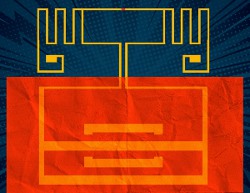 |
| March 17, 2020 | Volume 16 Issue 11 |
Designfax weekly eMagazine
Archives
Partners
Manufacturing Center
Product Spotlight
Modern Applications News
Metalworking Ideas For
Today's Job Shops
Tooling and Production
Strategies for large
metalworking plants
Electronic devices without cords, batteries being developed for military

Army researchers are collaborating on an antenna that can absorb Wi-Fi, Bluetooth, and cellular signals and efficiently turn them into usable electrical energy -- technology that has the potential to revolutionize Soldier situational awareness and readiness. [Photo Credit: U.S. Army]
Imagine if you could wrap a small, thin piece of transparent material around any surface and it would charge electronic devices such as your phone or laptop. Thanks to Army researchers, this idea could be a reality for future warfighters in combat.
A team led by Professor Tomás Palacios at the Massachusetts Institute of Technology (MIT) and Dr. Madan Dubey, a research physical scientist at the U.S. Army Combat Capabilities Development Command's Army Research Laboratory (ARL in Adelphi, MD), has conducted a game-changing study describing an antenna that can absorb Wi-Fi, Bluetooth, and cellular signals and efficiently turn them into usable electrical energy. Their work is published in the high-impact journal Nature.
"Today, Wi-Fi is becoming increasingly omnipresent in both indoor and outdoor environments and provides an abundant source of always-on radiofrequency energy," Dubey said. "What's missing is an efficient, flexible, and always-on energy-harvesting solution to power devices, which is indispensable for self-powered systems. We have discovered a way to potentially fill this gap and to make it useful for Soldiers on the battlefield."
Dubey said the invention has proven the potential for a conformal, atomically thin layer of material for generation of power without any power cords using Wi-Fi, Bluetooth, and millimeter wave signals used in some 5G wireless communication systems.
"It has the potential to revolutionize Soldier situational awareness and readiness, as these materials and devices can be integrated into health and monitoring systems, displays, communication, and sensing systems for the Soldier," Dubey said.
At the center of all of these components is a new revolutionary material, molybdenum-di-sulphide, or MoS2, which is only a few atoms thick. Its extreme thinness allows the electronics systems made out of it to be transparent, and only become visible when designed for displaying information.
"The technology is a game-changer for the Army and Department of Defense as it will enable a transparent, flexible/conformal, self-powered, atomically thin system on a chip embedded in a smart textile that has never been realized before," Dubey said. "These future systems will feature micron size, light weight, optical transparency, and state-of-the-art transistors and sensors to provide the Soldier with real-time information (and) prepare for planning/action and security in all terrain. If the team's radio wave absorber succeeds, it will power those ever-present electronics 24/7, no battery needed."
"The enabling technology is very critical for Army modernization formulation in Multi-Domain Operations," Dubey said. "It will be a game-changer technology to power devices that will enable higher Soldier lethality, improve cognitive neuroscience, and (develop) the novel engineered materials required for the Next Generation Combat Vehicle."
According to Dubey, this technology is a key building block to create, for example, an Alexa-like device that is 1,000 times smaller in size, but much more powerful in performance, while being flexible and conformable to meet mission requirements.
For Dubey, this research would not be as successful if it weren't for the collaboration between the laboratory and MIT.
"MIT has been, and continues to be, a true and trusted partner with several successful proven achievements through the Institute for Soldier Nanotechnologies," Dubey said. "ARL has established a very strong collaboration and partnership through the visit/exchange of researchers and scientists participating at the bench level."
The Institute for Soldier Nanotechnologies is a team of MIT, Army, and industry partners working together to discover and field technologies that dramatically advance Soldier protection and survivability capabilities.
The demonstrated energy harvester could have a huge impact on future systems and is one of several components the MIT-Army team is jointly developing to transform the electronic microsystems that provide situational awareness and intelligence to the Soldier.
SIDEBAR: How it works -- converting Wi-Fi and other signals to usable power
By Rob Matheson, MIT
Devices that convert AC electromagnetic waves into DC electricity are known as "rectennas." The researchers have demonstrated a new kind of rectenna, described in the Nature study, that uses a flexible radio-frequency (RF) antenna that captures electromagnetic waves, including those carrying Wi-Fi, as AC waveforms.

The MIT-led research team designed the first fully flexible, battery-free "rectenna" (a device that converts energy from Wi-Fi signals into electricity) that could be used to power flexible and wearable electronics, devices, and sensors. [Image: Christine Daniloff]
The antenna is then connected to a novel device made out of a two-dimensional semiconductor just a few atoms thick. The AC signal travels into the semiconductor, which converts it into a DC voltage that could be used to power electronic circuits or recharge batteries.
In this way, the battery-free device passively captures and transforms ubiquitous Wi-Fi signals into useful DC power. Moreover, the device is flexible and can be fabricated in a roll-to-roll process to cover very large areas.
All rectennas rely on a component known as a "rectifier," which converts the AC input signal into DC power. Traditional rectennas use either silicon or gallium arsenide for the rectifier. These materials can cover the Wi-Fi band, but they are rigid. And, although using these materials to fabricate small devices is relatively inexpensive, using them to cover vast areas, such as the surfaces of buildings and walls, would be cost prohibitive. Researchers have been trying to fix these problems for a long time. But the few flexible rectennas reported so far operate at low frequencies and can't capture and convert signals in gigahertz frequencies, where most of the relevant cell phone and Wi-Fi signals are.
To build their rectifier, the researchers used a novel 2D material called molybdenum disulfide (MoS2), which at three atoms thick is one of the thinnest semiconductors in the world. In doing so, the team leveraged a singular behavior of MoS2: When exposed to certain chemicals, the material's atoms rearrange in a way that acts like a switch, forcing a phase transition from a semiconductor to a metallic material. The resulting structure is known as a Schottky diode, which is the junction of a semiconductor with a metal.
Parasitic capacitance is an unavoidable situation in electronics where certain materials store a little electrical charge, which slows down the circuit. Lower capacitance, therefore, means increased rectifier speeds and higher operating frequencies. The parasitic capacitance of the researchers' Schottky diode is an order of magnitude smaller than today's state-of-the-art flexible rectifiers, so it is much faster at signal conversion and allows it to capture and convert up to 10 gigahertz of wireless signals.
The reported work provides blueprints for other flexible Wi-Fi-to-electricity devices with substantial output and efficiency. The maximum output efficiency for the current device stands at 40 percent, depending on the input power of the Wi-Fi input. At the typical Wi-Fi power level, the power efficiency of the MoS2 rectifier is about 30 percent. For reference, today's rectennas made from rigid, more expensive silicon or gallium arsenide achieve around 50 to 60 percent.
Sources: CCDC Army Research Laboratory, MIT
Published March 2020
Rate this article
View our terms of use and privacy policy
